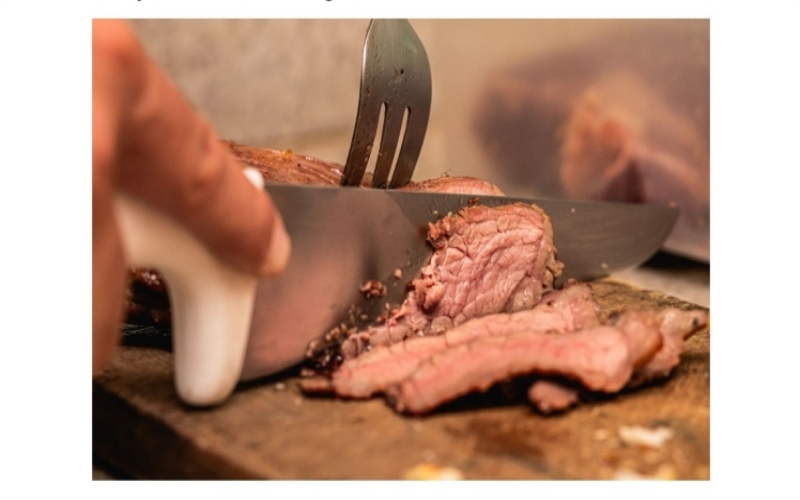
Do you ever wonder why your steak can be tough and difficult to chew, even when cooked to perfection? The answer may lie in how you cut it. Cutting against the grain of meat can make a huge difference in the tenderness and overall enjoyment of your meal.
By the end of this article, you’ll have a better understanding of why cutting against the grain is the way to go and other cutting techniques to consider.
Key Takeaways
- Cutting against the grain is important because it makes the meat more tender and easier to chew.
- Meat fiber composition, cooking techniques, and choosing the right cut of meat can affect tenderness.
- Seasoning and marinating techniques, as well as brine and dry rub, can enhance flavor.
- Safety precautions, such as using a sharp knife, cutting away from your body, and keeping your fingers clear of the blade, should be followed.
So Why Cut Against the Grain?
When it comes to cutting meat, going against the grain can actually improve the texture and tenderness of your dish.
By cutting against the grain, you are breaking up the muscle fibers, which makes the meat easier to chew and digest. This also enhances the flavor and juiciness, as the meat is able to retain more of its natural juices.
Meat fiber composition is an important factor in determining the tenderness of a cut of meat. These fibers run the length of the muscle and are made up of bundles of protein filaments. When cooked, the heat causes these filaments to contract and the muscle fibers to shrink, resulting in a tougher texture.
Cooking techniques can also affect the tenderness of a cut of meat. Searing the outside of a steak at high heat can create a crust that locks in the moisture, but can also cause the muscle fibers to tighten and become tougher.
This is where cutting against the grain comes in. By cutting perpendicular to the grain, you are essentially cutting through the muscle fibers and shortening them, making the meat more tender and easier to chew.
How to Identify the Grain of Meat
We asked the team at Carnivorous Life to provide their best tips to identify the grain of the meat.
First, take a close look at the surface of the meat and find the direction the muscle fibers are running. This will help you easily identify the grain and ensure a tender and flavorful cut. Cutting against the grain means slicing perpendicular to these muscle fibers, creating shorter strands of meat that are easier to chew and digest.
To identify the grain direction, look for the long, parallel lines that run through the meat. Once you’ve located the grain, use a sharp knife to slice thinly against it. Remember that cutting with the grain will result in tougher, chewier pieces of meat that may not be as enjoyable to eat.
By taking the time to properly identify the grain direction, you’ll be able to determine the quality of the meat and create a delicious, tender steak that will impress your dinner guests.
The Importance of Preparing Meat Properly
When it comes to preparing meat, there are a few key factors you need to consider to ensure a tasty and enjoyable meal.
By paying attention to these factors, you can create delicious and satisfying meals every time.
Choosing the Right Cut of Meat
To choose the right cut of meat for your steak, you should look for marbling and consider the tenderness of the meat. Different cuts of meat have varying levels of fat, which affects the tenderness and flavor of the steak.
For example, a ribeye steak has more marbling than a filet mignon, which some people prefer the taste of having more fat. On the other hand, a filet mignon has less marbling but is more tender (hence the tenderloin)
When choosing a cut of meat, it’s also important to consider the cooking method. Some cuts of meat are better suited for grilling or broiling, while others are better for slow cooking or braising.
For instance, a flank steak is best grilled or broiled, while a chuck roast is better suited for slow cooking in a crockpot.
Seasoning and Marinating Techniques
A brine is a mixture of salt, sugar, and water that is used to soak the meat before cooking. This helps to keep the meat moist and tender, while also infusing it with flavor.
A dry rub is a mixture of spices that is rubbed onto the meat before cooking. This creates a flavorful crust on the outside of the steak, while also adding moisture to the inside.
Frequently Asked Questions
What is the best type of knife to use for cutting against the grain?
When cutting against the grain, a serrated knife is better than a straight knife.
Can cutting against the grain affect the tenderness of the meat?
Cutting against the grain can affect the tenderness of the meat. Tenderizing techniques such as marinating or using a meat mallet can help. Cooking methods such as slow-cooking or braising can also make the meat more tender.
Will cutting against the grain affect the flavor of the steak?
Cutting against the grain won’t affect the flavor of the steak, but it will makechewing the steak much more difficult which can create a less enjoyable experience.
